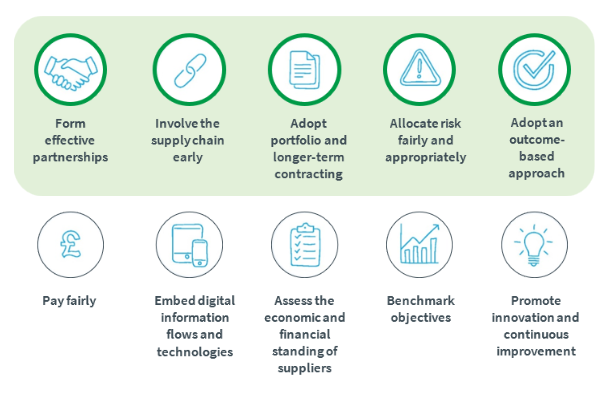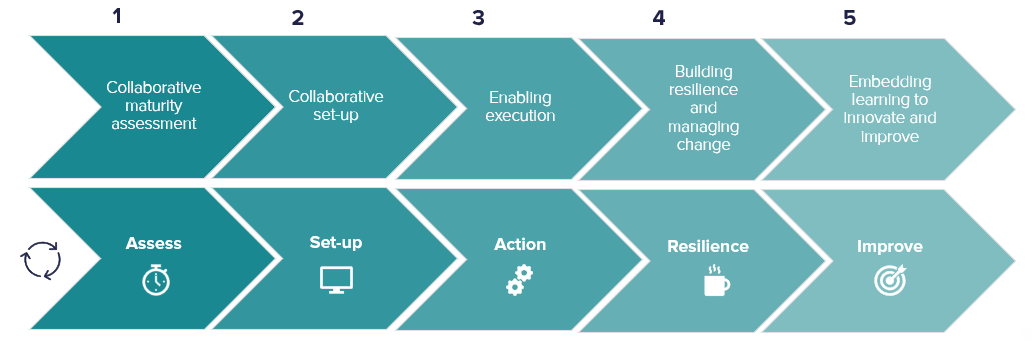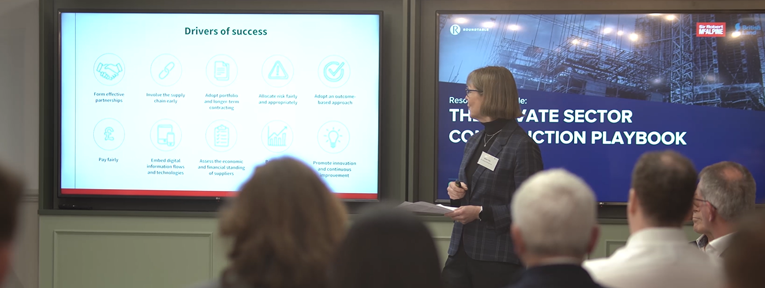The discussion yesterday evening focused on the Private Sector Construction Playbook, a best practice guide published in November 2022. We were joined by two guest speakers, Alison Cox, Managing Director of Sir Robert McAlpine London Charles Horne, Project Director of British Land and, ResoLex Chief Executive Edward Moore.
Our Principal Consultant, Kelachi Amadi-Echendu began the session, by describing the journey from the government’s Construction Playbook to today’s Private Sector Playbook. She explained how the themes from the ResoLex publication ‘Changing Behaviours in Construction: A Complement to the Construction Playbook’, apply not only in the public sector but also to private sector projects and programmes, to enable improved delivery and better outcomes.
“Historically, the UK construction industry has been characterised by a lack of openness, poor productivity and a failure to invest in innovation”.
Foreword, Trust and Productivity The Private Sector Construction Playbook, November 2022
With many years of experience in the sector, driving excellence and delivering complex and challenging solutions for clients, we were delighted to have Alison Cox join us. Alison began explaining that the Private Sector Playbook was created by the construction productivity taskforce, a working group of developers, contractors, suppliers and professional service providers from the private sector whose underlying purpose is to try and improve productivity in the construction industry. She noted that whilst productivity had improved in a number of sectors, construction productivity had actually declined by 0.6% in the last 20 years. The document was designed to complement the Public Sector Construction Playbook that was released in 2020, taking cues from the public sector whilst understanding the challenges faced by the private sector.
The Playbook is structured around ten key drivers for success, as illustrated in the diagram below. It is interesting to note that half of these focus on culture and behaviours. Alison emphasised the need to concentrate on building the right relationships, particularly at the beginning of a project. She mentioned her own experiences on the construction of the Bloomberg offices where key members of the different teams sat in close proximity in a co-located office. This was a project that was quite dynamic and required the team to be highly adaptable to changes in requirements. The strength of relationships established in the early phases of the project enabled the teams involved to focus on ‘best for project’ decisions, rather than solutions which might be best for individual organisations.

Charles observed the many changes in the construction industry since his experiences working on sites in the mid-1980s, as illustrated by the massive shift in safety that now exists compared to forty years ago. He highlighted the cultural change around health, safety and wellbeing, which simply did not feature when he first began his career. His primary observation is that projects are delivered by people rather than by technology or process. His recent experiences are drawn from Broadgate, where British Land is developing seven consecutive significant buildings under the Broadgate Framework. His starting point for creating the development strategy was the recognition that the customers for these properties are the local users in the area, and as such, care needs to be taken to avoid creating major disruption as the construction works to proceed. Charles’ approach required working with partners rather than suppliers, and so, in a significant break from traditional procurement practices, British Land has entered into a 10-year framework agreement with Sir Robert McAlpine. The framework enables British Land to reduce the risk of multiple concurrent projects and promotes consistency, continuity and innovation.
Contractual mechanisms aside, Charles, focused from the start on establishing an underlying ethos for the programme, based on the principles of Trust, Honesty and Collaboration. These principles have been developed into a set of rules, which every individual involved in the projects are expected to follow. The rules are generally self-policed, and there are very few instances where they are not applied by the numerous teams engaged in the programme. Charles identified a critical role that leadership plays in establishing a successful culture, recognising that in a collaborative contract, leaders need to be skilled at building ‘followership’.
He recognised the challenges of complexity and used the analogy of a pebble dropping into a pond and creating small waves. As projects grow in size and scale, leaders must deal with the challenge of lots of pebbles, dropping into the pool at the same time each creating ripples which intersect and disrupt with each other. He agreed with Alison that co-location is a critical factor in building cohesive and collaborative teams and is fundamental to building teamwork and understanding.
Ed Moore identified the need to establish the right culture from the start, quoting Abraham Lincoln, who said ‘give me six hours to chop down a tree and I would spend the first four sharpening the axe’. Ed made the case that programmes should treat relationship development as a distinct and separate workstream with its own targets and deliverables. Ed observed that too many project leaders tend to assume that their teams will naturally form into collaborative teams and therefore ignore the opportunity to shape the behaviours which occur at the very start. Ed also highlighted the need for project and programme teams to introduce a framework to help teams structure their workstream, and gave an example of the ASARI framework created by ResoLex as illustrated below:

Some of the key points of the discussion from the floor, were as follows:
- Project culture is directly linked to the quality of leadership.
- A critical skill for project leaders is to learn to listen to other points of view rather than press on with their sole perspective as to how a problem should be solved.
- The time for the individual heroic project director has passed. The role of the project director is now to build leadership throughout the team.
- The primary barrier to industry-wide adoption of the Private Sector Playbook remains a driver amongst many clients to appoint the lowest tender, thus propagating the bad habits, behaviours and relationships that inevitably emerge from such practices.
- The key to wider adoption must be to focus on being able to clearly articulate the difference between value over cost and use the successes of previous projects to persuade others to continue to support a route based on effective relationships.
As a final comment, Charles pointed out that on Broadgate, each of the individual projects is still negotiated within the framework. He nevertheless observed that not one contractual letter has yet been issued by either party throughout the delivery of the programme. As he put it, when a difficult issue arises it is ‘our’ problem, not just ‘your’ problem. This is a great illustration of collaboration working in practice.
You can find the featured publications linked below:
- Changing Behaviours in Construction: A Complement to the Construction Playbook
- Trust and Productivity – The Private Sector Construction Playbook
